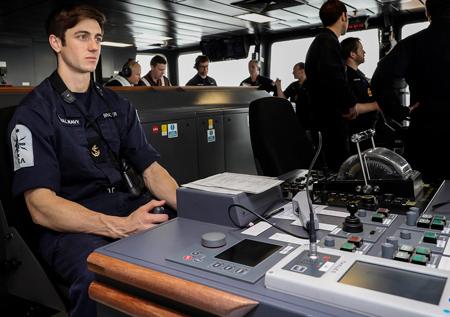HMS Queen Elizabeth sails into Portsmouth
HMS Queen Elizabeth has now arrived in Portsmouth following her departure from Rosyth, Scotland and the latest round of sea trials. Thales is playing a significant role in the running of the 65,000-tonne warship, being a founding member of the Aircraft Carrier Alliance and providing key equipment on-board.
The arrival of HMS Queen Elizabeth into her home port of Portsmouth Naval Base marks a key phase of the carrier’s journey, prior to the Royal Navy’s official acceptance of the ship later this year, with the exact date and time of the docking not being announced until yesterday due to changing weather conditions. The naval base has spent a year and a half preparing for the moment, which has seen over 20,000 items dredged up from Portsmouth Harbour.

Further to this, Thales is providing the communications systems on-board both carriers. The systems, from wireless on-board to satellite connectivity, allow the staff on the ships to talk to each other, the aircraft, the rest of the Navy and associated task groups, as well as allies, civilian vessels and air traffic with complete security, anywhere in the world.
Power and propulsion is a crucial element of the QEC programme. Comprising Rolls Royce, GE Energy and L-3, Thales has led the sub-alliance to deliver a distribution network that will generate enough energy to support both ships – the equivalent of a large town. Collaboration has been a necessity in delivering other requirements too, including for the implementation of the long-range S1850M radar, which has been supplied by Thales in the Netherlands.
As part of the QEC project on a broader level, Thales has also been involved in the designing of some of the aircraft due to be transported by the carriers; the Merlin Mk2 helicopters, which are fitted with Thales’s Folding Light Acoustic System for Helicopter (FLASH) Dipping Sonar. The FLASH Dipping Sonar allows the helicopters to locate and track submarines in deep and littoral waters, even in high reverberation and noisy conditions. Plus, the Merlin Mk2 helicopters are fitted with Thales’s Cerberus mission system and Searchwater radar as part of the Crowsnest solution, enabling the aircraft to provide the QEC carriers with vital intelligence, surveillance and tracking.
Victor Chavez, Chief Executive of Thales in the UK, says:
“The Royal Navy must be incredibly excited to see HMS Queen Elizabeth sailing into her new home at Portsmouth today as this represents an advancement in our UK maritime capability. It is a milestone event for the Navy, the Ministry of Defence and the Aircraft Carrier Alliance. All employees who have been involved in this landmark programme should feel a sense of pride today. Thales’s sensors, systems and capabilities will help the carrier carry out the demands of operational life at sea for many years to come, helping to protect the ship and the ship’s company.
“It has been a real team effort and to see such an iconic example of British engineering sailing in to her new ‘home’ is an achievement we should all be justifiably proud of.”
Thales will now continue to support the QEC programme during a period of planned engineering, in order to prepare HMS Queen Elizabeth for the mission system sea trials later this year.
To find out more about Thales’s involvement in the QEC programme, click here.